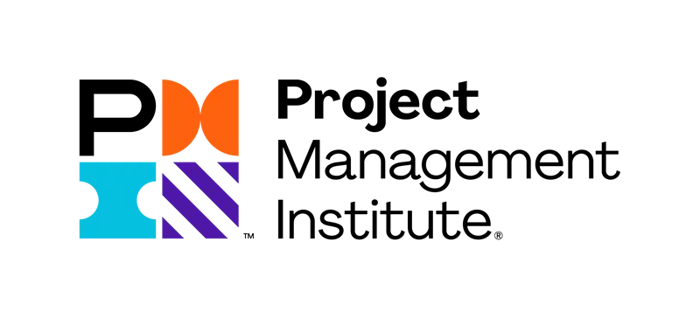Table of Contents
- The Truth About PMP Recertification (And Why It’s Like Your Gym Membership)
- Why PMP Recertification Matters More Than Ever?
- How to Maintain Your PMP Certification in 2025
- Top Strategies to Make Recertification Easier
- The Future of PMP Recertification: What to Expect in 2025
- Common Mistakes to Avoid in PMP Recertification
- 10 Less Commonly Known Facts About PMP Recertification
- Final Thoughts: Stay Certified, Stay Ahead
- FAQs
The Truth About PMP Recertification (And Why It’s Like Your Gym Membership)
You know how you sign up for a gym membership, full of motivation, only to realize a year later that you’ve barely used it? Well, PMP recertification is kind of like that—except skipping it could cost you your hard-earned certification. If you want to stay relevant in 2025 (and beyond), understanding the PMP recertification process is crucial. This guide will walk you through everything you need to know, from PDUs to renewal fees and the best strategies to keep your PMP status active. And don’t worry, we’ll make this fun (well, as fun as recertification can be) with some charts, infographics, and expert insights.
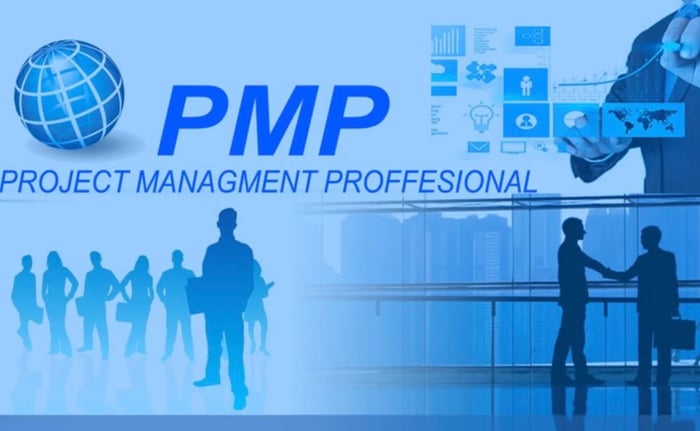
Why PMP Recertification Matters More Than Ever?
The world of project management is evolving rapidly, and staying certified is more than just a checkbox—it’s a necessity. With new methodologies like hybrid project management gaining traction, PMP holders must adapt or risk being left behind.
95% of organizations demand certified project managers (PMI)
PMP-certified professionals earn 32% more than their non-certified peers (Project Management Institute)
Failure to recertify can mean losing lucrative job opportunities
Simply put, PMP recertification ensures you stay competitive, knowledgeable, and in demand.
How to Maintain Your PMP Certification in 2025
Recertification may seem daunting, but breaking it into manageable steps makes it much easier. The key is to continuously engage in professional development and track your progress regularly. Whether through formal education, on-the-job learning, or community involvement, earning PDUs should become a habit rather than an afterthought. Keeping up with industry trends and new PMI requirements will ensure that you remain a valuable asset in your field. Plus, having a structured plan in place will help you avoid the stress of last-minute PDU accumulation.
1. Understanding the PDU Requirement
Professional Development Units (PDUs) are the currency of PMP recertification. You need 60 PDUs every three years to maintain your certification. Here’s how they break down:
Category | Minimum Required | Maximum Allowed |
Education (Technical, Leadership, Strategic) | 35 PDUs | No Maximum |
Giving Back (Creating Content, Volunteering) | 25 PDUs | 25 PDUs |
How to Earn PDUs Efficiently
Attend PMI-sponsored webinars (PMI)
Take courses in Agile, AI, or digital transformation
Create project management content (articles, podcasts, or courses)
Mentor or train upcoming project managers
2. Completing Your Recertification Application
Once you’ve gathered your PDUs, submitting them through the PMI Continuing Certification Requirements System (CCRS) is straightforward. PMI typically reviews applications within 5-7 business days.
3. Paying the Recertification Fee
Expect to pay $60 for PMI members and $150 for non-members. This small fee ensures your PMP status remains active for another three years.
Top Strategies to Make Recertification Easier
Many PMP holders struggle with recertification simply because they don’t plan ahead. The key to making it easier is consistency and a proactive approach to earning PDUs. Instead of scrambling for credits in your final year, set annual goals and monitor your progress. There are also numerous free or low-cost resources available to help you accumulate PDUs without breaking the bank. Additionally, leveraging industry events, mentorship programs, and content creation can make the process more engaging and fulfilling.
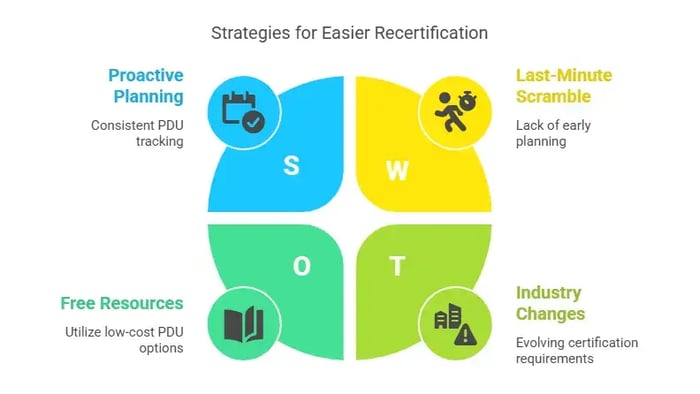
1. Plan Your PDUs in Advance
Don’t wait until the last minute. Track your PDUs using a spreadsheet or PMI’s PDU tracker to avoid a last-minute scramble.
2. Leverage Free and Low-Cost PDU Opportunities
Many platforms, like Coursera, offer free project management courses that qualify for PDUs. Don’t overlook podcasts, webinars, and community contributions.
3. Network and Learn
Joining a PMI chapter helps you earn PDUs while networking with industry leaders.
The Future of PMP Recertification: What to Expect in 2025
The recertification landscape is continuously evolving, with new trends shaping how professionals maintain their credentials. In 2025, PMI is expected to introduce more AI-driven learning experiences to help tailor recertification paths to individual career goals. Additionally, there is an increasing focus on leadership and strategic thinking skills, meaning PDUs related to soft skills will become just as important as technical knowledge. Organizations are also placing greater emphasis on agile methodologies, hybrid project management approaches, and sustainability in project execution.
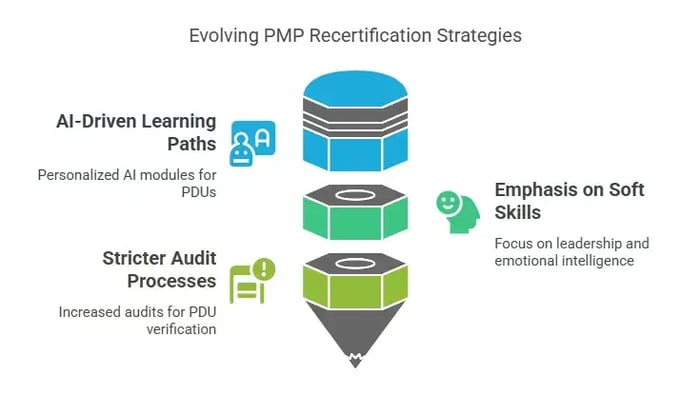
1. More AI-Driven Learning Paths
Expect more AI-powered learning modules that tailor PDU recommendations based on your career goals.
2. Greater Emphasis on Soft Skills
Leadership and emotional intelligence PDUs will become just as critical as technical skills.
3. Stricter Audit Processes
PMI is increasing audits, ensuring professionals actually earn their PDUs.
Common Mistakes to Avoid in PMP Recertification
PMP recertification may seem straightforward, but many professionals unknowingly make mistakes that delay their renewal or, worse, lead to certification suspension. Here are some of the most common pitfalls:
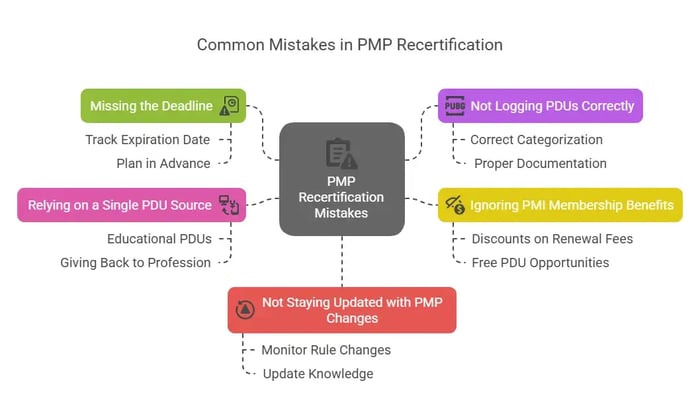
- Missing the Deadline – The PMP certification cycle is three years, and failing to submit PDUs in time can result in suspension. Always track your certification expiration date and plan well in advance.
- Not Logging PDUs Correctly – PMI requires specific categories of PDUs (education, giving back, and technical leadership). If you incorrectly categorize or fail to provide proper documentation, you may face issues during the audit process.
- Ignoring PMI Membership Benefits – PMI members receive discounts on renewal fees and exclusive access to free PDU-earning opportunities. Many professionals overlook these benefits and end up paying more than necessary.
- Relying on a Single PDU Source – PMI requires a balance between educational PDUs and giving back to the profession. Many professionals mistakenly focus on only one category, leading to last-minute struggles to meet requirements.
- Not Staying Updated with PMP Changes – PMI occasionally updates its recertification rules, PDU categories, or requirements. If you're not aware of the latest changes, you may end up following outdated methods.
By avoiding these common mistakes, PMP professionals can ensure a smooth recertification process and maintain their credentials without unnecessary stress.
10 Less Commonly Known Facts About PMP Recertification
PMP certification holders outperform non-certified project managers by 32% in salary (Pay Scale)
80% of high-performing projects are led by certified PMPs (PMI)
You can earn PDUs by reading project management books.
PMI has introduced AI-driven PDU tracking tools.
You can roll over extra PDUs to the next cycle.
PMP certification is recognized in over 200 countries.
PMI has partnerships with major universities offering PMP courses.
The PMP recertification process has been streamlined since 2023.
You can earn PDUs by speaking at industry events (PMI)
Recertification is linked to job promotions in 75% of cases (Glassdoor)
Final Thoughts: Stay Certified, Stay Ahead
If you want to remain competitive in project management, PMP recertification isn’t optional—it’s essential. Don’t let your certification lapse! Check out APMIC’s project management certifications for the best training options to keep your career on track.
By following this guide, you’ll be well-equipped to navigate PMP recertification in 2025 with confidence. Stay ahead, keep learning, and don’t let your certification lapse!
FAQs
What happens if my PMP certification expires?
If your PMP certification expires, you have one year to reinstate it by completing your PDUs and paying a late fee.
Can I renew my PMP certification without PDUs?
No. PDUs are mandatory for renewal.
How many PDUs do I need per year?
You should aim for 20 PDUs per year to meet the 60-PDU requirement in three years.
What are the best ways to earn free PDUs?
Webinars, PMI chapters, online courses, and volunteering are excellent sources of free PDUs.
How long does PMI take to process recertification applications?
PMI typically processes applications within 5-7 business days.
Is there a grace period for PMP recertification?
Yes, there is a one-year grace period, but you won’t be considered an active PMP during this time.
Can I recertify without being a PMI member?
Yes, but PMI members pay a reduced renewal fee.
Do I need to take the PMP exam again for recertification?
No. As long as you maintain your PDUs and submit your renewal on time, you won’t need to retake the exam.





